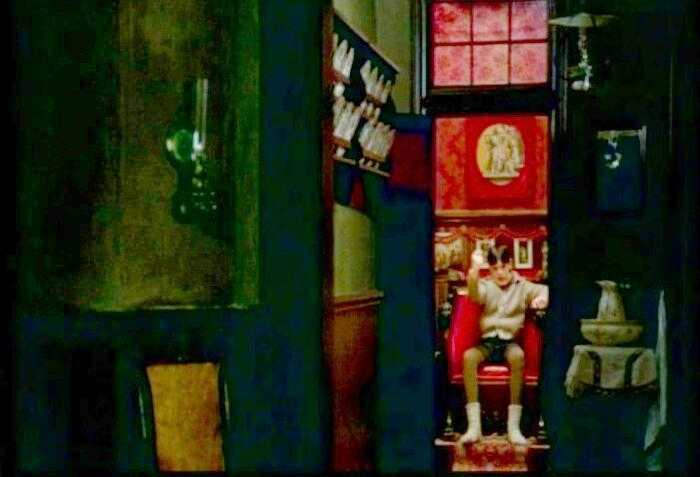
Uncut Version of Fanny och Alexander / Fanny and Alexander - (Sweden, 1983)

Figure 1.--The image seen here shows the 10 year-old Alexander in the "Prologue" to the movie watching his toy theatre from a red plush chair and imagining himself as a theatrical director--an interesting conception of Bergman the artist himself as a child.
|
|
A HBC reader has mentioned the uncut version (over five hours) of the original version of Bergman's masterpiece, "Fanny and Alexander" (1983). The cut version that Bergman made for commercial release in cinemas around the world is considered by film critics to be artistically inferior to Bergman's original conception. Recently the full version has been made available. It contains many scenes
that are omitted from the so-called theatrical version. Our reader has provided some information on the uncut version.
Toy Theater
The image seen here shows the 10 year-old Alexander in the "Prologue" to the movie watching his toy theatre from a red plush chair and imagining himself as a theatrical director (figure 1). This is of course an interesting conception of Bergman the artist himself as a child. Alexander's clothes are meticulously correct historically for the
period--Sweden in 1907. He wears a turtle-necked sweater, very short knee pants, and brown long stockings with supporters (in one scene you can see the garters attached to a Leibchen). When he is playing indoors at his grandmother's large house, he wears no shoes and pulls short white ankle socks over the stockings. You can see the white socks in this shot. Notice also the center part in his hair. These are the kinds of details that make this film so valuable from the point of view of boys' period clothing. Toy theaters were popular in the late 19th and early 20th century, in part because many children enjoyed the Punch and Judy shows which were common in parks and beach resorts throughout Europe.
The second shot shows Fanny and Alexander in the clothes they wore to the marriage ceremony of their troubled mother when, after the death of Alexander's father, she remarried the puritanical Lutheran Bishop. Whereas the first shot shows Alexander's winter play clothes, the second shot shows his dress-up summer clothes. He wears a light blue sailor suit with a large white collar, knee pants, long black stockings, and hightop shoes. Fanny also
wears a sailor-style dress that complements what her brother is wearing. The two children are walking in the street behind the newly married couple after the marriage ceremony has taken place. The children are unhappy about their mother's choice of a second husband and sense the harsh regime upon which they
are about to enter when they move into the bishop's spartan residence--a tremendous contrast to the warm and luxurious home in which they were both brought up and to which we are introduced in the earlier part of the film. Notice the formality of the dress here--both for the children and for the
adults.
The third shot shows Alexander in the Elizabethan costume he wore as an extra for a production of Shakespeare's "Twelfth Night" in the town theatre, managed by his mother after the death of his actor-father. The uncut TV version of the film makes a great deal of the contrast between the fanciful theatricalism of the Eckdahl family and the grim Protestant religiosity of the home that
Fanny and Alexander have to accept after their mother's second marriage. Both the children are very close to the profession of their parents who are theatre people, and Alexander gets to appear as a supernumerary in his mother's production of the Shakespearean comedy, "Twelfth Night". This is an appropriate play to be used in the film because it is a subtle mixture of sadness and joy, of humorless puritanism and care-free spirits, of marriage
and death. These are themes that pervade Bergman's entire film and with which Alexander's childhood is personally involved. So it is fitting that we should see him here dressed as a page and wearing a red doublet and white hose (tights).
HBC

Navigate the Boys' Historical Clothing Web Site:
[Return to the Main Fanny and Alexander page]
[Return to the Main Swedish movie page]
[Introduction]
[Activities]
[Biographies]
[Chronology]
[Clothing styles]
[Countries]
[Topics]
[Bibliographies]
[Contributions]
[FAQs]
[Glossaries]
[Satellite sites]
[Tools]
[Boys' Clothing Home]
Created: 11:31 PM 12/17/2004
Last updated: 11:31 PM 12/17/2004



